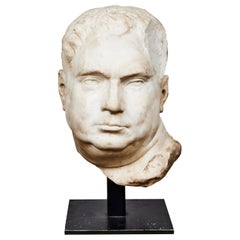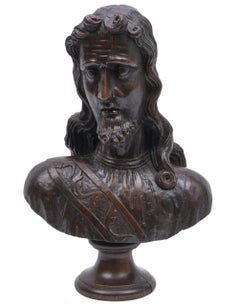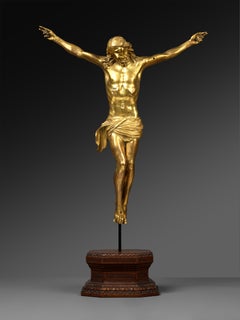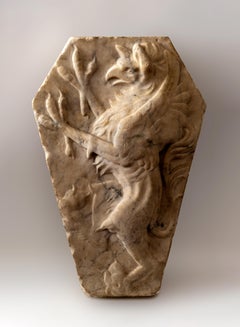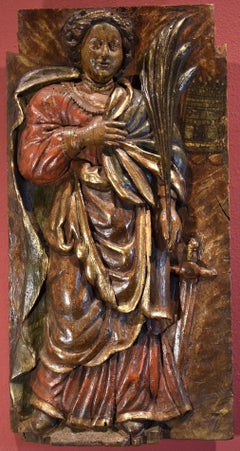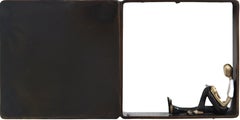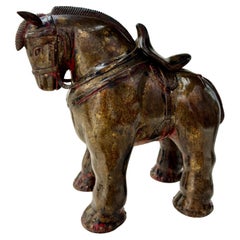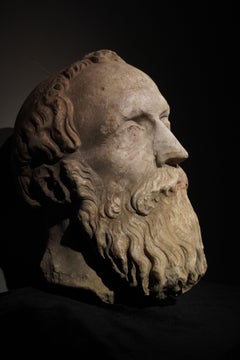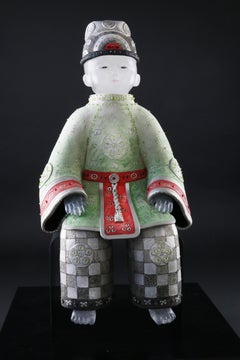16th Century Figurative Sculptures
to
3
7
8
2
4
Overall Width
to
Overall Height
to
173
580
2,211
7,431
71
54
106
116
61
123
201
173
219
268
57
1
18
11
10
10
9
7
5
4
3
3
2
2
1
1
1
1
1
1
1
1
10
8
5
3
3
19
2
Period: 16th Century
Antique Bust of Roman Emperor Vitellius
Located in Los Angeles, CA
Substantial, hand carved, solid marble bust of Roman Emperor Vitellius (24-69 C.E.) on a custom, iron base. Likely a 16th century copy of a 2nd century o...
Category
16th Century Figurative Sculptures
Materials
Marble
A Monumental 16th Century Renaissance Carved Oak Bust of Jesus Christ
Located in Queens, NY
Magnificent and Monumental 16th Century Renaissance Carved Oak Bust of Christ, Flemish Netherlandish, C. 1550
A powerful and deeply expressive Renaissance carved oak bust of Jesus C...
Category
16th Century Figurative Sculptures
Materials
Oak
GILT BRONZE FIGURE OF CRISTO MORTO ATTR. G DELLA PORTA, ITALIAN RENAISSANCE
Located in Milan, IT
Circle of Guglielmo Della Porta
(Porlezza, 1515 circa – Rome 1577)
CRISTO MORTO, Italy, mid 16th Century
Gilt bronze
54 x 48 cm
21 1/4 x 19 in
Provenance:
M. Barbagli Private Collec...
Category
16th Century Figurative Sculptures
Materials
Bronze
ITALIAN RENAISSANCE MARBLE RELIEF WITH GRIFFIN
Located in Milan, IT
ITALIAN RENAISSANCE MARBLE RELIEF WITH GRIFFIN Central Italy, 16th Century
marble
42 x 28.5 x 5.5 cm
16 1/2 x 11 1/4 x 2 1/4 in
Category
16th Century Figurative Sculptures
Materials
Marble
Virgin and Child
Located in Wien, Wien
OUTSTANDING MADONNA
Bavaria
Around 1515/20
Lime wood carved
Original, polychrome version
Height 60 cm
This masterfully carved, full-round Madonna was created around 1515-20 in...
Category
Medieval 16th Century Figurative Sculptures
Materials
Wood
$180,000
Saint Barbara France 16/17th Century Sculpture Wood Religious Old master Art
Located in Riva del Garda, IT
High relief panel depicting 'Saint Barbara'
Southern France, 16th-17th century
Polychrome carved wood with traces of gilding
64 x 32 cm.
(good condition, with minor missing and cra...
Category
Old Masters 16th Century Figurative Sculptures
Materials
Wood Panel, Wood
Master Angel
Located in Wien, Wien
MASTER ANGEL
Museum sculpture of the master of Mauer
Austrian Danube Region
Around 1500/20
Lime wood, carved full round
Height 55 cm
Provenance:
Hofstätter Collection, Vienna
The masterful sculpture was made in the workshop of the master of the altar of Mauer around 1500 in Lower Austria. It can be located in the context of the Danube school of the first third of the 16th century, was carved from limewood and is 55 cm tall. Since there are no attributes or context, it is an unknown figure of a carved altar.
The master of the altar of Mauer is an anonymous Gothic carver who was active between 1500 and 1525 and received this so-called emergency name through the altar for the parish and pilgrimage church of Mauer near Melk. This winged altar was probably commissioned by Göttweig Abbey in the 1470s and is made of lime wood. It shows an expression in the transition from late Gothic to early Renaissance and is considered the most important carved altar in Lower Austria, created between 1510-15.
The figure presented here is very related in its design to the figures of the altar of Mauer. In lively-moving form, the male figure turns his upper body to the right, with his head pointing upward, probably toward the sky. The right leg in lunge emerges from under the frock...
Category
16th Century Figurative Sculptures
Materials
Wood
$38,000
Hl. Hieronymus
Located in Wien, Wien
St. Jerome
347 Stridon, Croatia - 420 Bethlehem
Around 1500/20
Limestone
Remains of the original polychromy
Height 45 cm
The man with the holy name!
347 Stridon, Croation – 420 Be...
Category
16th Century Figurative Sculptures
Materials
Limestone
$28,800
LARGE ITALIAN RENAISSANCE MARBLE CAPITAL, 15th/16th Century
Located in Milan, IT
LARGE ITALIAN RENAISSANCE MARBLE CAPITAL
Florence, 15th/16th Century
marble
38 x 47 x 47 cm
15 x 18 1/2 x 18 1/2 in
Category
16th Century Figurative Sculptures
Materials
Marble
Sheath In Sea Green And Red Marble From Caunes-minervois Nineteenth
Located in ROUEN, FR
"Sheath In Sea Green And Red Marble From Caunes-minervois Nineteenth"
Marble green sea for the central part and surrounded by a red of Caunes-Minervois XIXè. Provenance:GalerieParisi...
Category
16th Century Figurative Sculptures
Materials
Marble
16th Century Venetian bronze sculpture of a Young Man in Armour
Located in Milan, IT
16th Century Venetian bronze sculpture of a Young Man in Armour attributed to the Florentine artist Andrea di Alessandri, called Il Bresciano (Fl...
Category
16th Century Figurative Sculptures
Materials
Bronze
ANTIQUE ITALIAN ARCHITECTURAL ELEMENTS WITH CHIMERAS
Located in Milan, IT
ARCHITECTURAL RELIEFS WITH CHIMERAS
Central Italy, 16th Century
green marble
26 x 25 cm
10 1/4 x 9 3/4 in
Category
16th Century Figurative Sculptures
Materials
Marble
Important Sculpture
Located in ROUEN, FR
"Important Sculpture
IMPORTANT SCULPTURE representing Saint Floran de Lorch in polychrome wood in its beautiful old polychromy. He is represented ...
Category
16th Century Figurative Sculptures
Materials
Wood
$8,122
Great Renaissance Serene Stone Sculpture of Greyhound Florence 16th century
Located in Pistoia, IT
16th-century Florentine sculptor, greyhound in pietra serena.
This fascinating sculpture, which has come down to us in fragmentary form, depicts a dog, an elegant greyhound crouching...
Category
Renaissance 16th Century Figurative Sculptures
Materials
Stone
Late Gotic Relief "Adoration of the Magi"
Located in Wien, Wien
LATE GOTIC RELIEF “Adoration of the Magi
Lower Rhine
Around 1500
Oak wood, plastically carved
Original, polychrome version
Height 51 cm, widt...
Category
Gothic 16th Century Figurative Sculptures
Materials
Wood, Oak
Pair Flying Angels
Located in Wien, Wien
MUSEUM PAIR FLYING ANGELS
Brabant/Brussels
Around 1500
Oak wood, full round carved
Height 40/38 cm
These two figures are a pair of flying angels mad...
Category
16th Century Figurative Sculptures
Materials
Wood, Oak
$38,000
Hand Carved Wooden Frame, 16th Century European School
Located in London, GB
Hand Carved Fruit Wood
Length: 16 inches (40.5 inches)
A striking, richly hand carved frame in high relief. It shows a rich decor of natural organic forms alongside a collection of ...
Category
16th Century Figurative Sculptures
Materials
Wood
Saint Sebastian Lombard school. Italian Renaissance Carved alabaster.
Located in PARIS, FR
Large Saint Sebastian finely carved in alabaster. The saint is attached to a column surmounted by a capital, beautiful soft features and superb hair wi...
Category
Renaissance 16th Century Figurative Sculptures
Materials
Stone, Alabaster
$8,375 Sale Price
20% Off
ITALIAN BRONZE FIGURE OF YOUNG CHERUB ON PORPHYRY BASE - ATT. TO ROCCATAGLIATA
Located in Milan, IT
Resting on a circular Egyptian porphyry base, this fascinating bronze figure of a young cherub is a striking example of the Venetian workmanship of the 16th Century. With the head tu...
Category
16th Century Figurative Sculptures
Materials
Bronze
Renaissance Italian sculptor - 16th century wood sculpture - Saint Maurus
Located in Varmo, IT
Carved wooden sculpture - Saint Maurus. Italy, 16th century.
54 x 30 x 110 cm (21.5 x 11.5 x 43.5 in).
Entirely carved and painted wood with traces of polychrome and gilding.
- In...
Category
Renaissance 16th Century Figurative Sculptures
Materials
Wood
$4,211 Sale Price
22% Off
Renaissance Italian sculptor - 16th century carved wood sculpture - Saint Robert
Located in Varmo, IT
Carved wooden sculpture - Saint Robert. Italy, 16th century.
54 x 30 x h 112 cm.
Entirely carved and painted wood with traces of polychrome and gilding.
- Inscribed on the base: "...
Category
Renaissance 16th Century Figurative Sculptures
Materials
Wood
$3,610 Sale Price
25% Off
Related Items
Unfolding Dreams - Modern Figurative Bronze Iron Metal Wall-Mounted Sculpture
By Mireia Serra
Located in Los Angeles, CA
Mireia Serra creates sensuous bronze and iron sculptures showing the beauty of snapshots caught in life which are full of emotions and feelings along the life journey. Her metal artw...
Category
Contemporary 16th Century Figurative Sculptures
Materials
Metal, Bronze, Iron
$1,245
H 10 in W 5 in D 1 in
Botero Style Bronze Horse Sculpture
Located in Lake Worth Beach, FL
Botero Style Bronze Horse Sculpture
Large and decorative bronze horse with removable saddle Botero style inspired, quality patinated bronze with some red and black trace of paint.
Category
Modern 16th Century Figurative Sculptures
Materials
Bronze
Modern High Relief George Bush Cast Metal Sculpture
Located in Houston, TX
Metal sculpture on wood by Houston, Texas modernist sculptor and painter David Adickes. High relief sculpture of George Bush facing right cast in metal and mounted on wood. Signed by artist.
Metal Sculpture Diameter: 6"
Artist Biography: Born 1927 in Huntsville, Texas, David Pryor...
Category
Modern 16th Century Figurative Sculptures
Materials
Metal
$1,800
H 8.13 in W 8.5 in D 1.75 in
LARGE ITALIAN RENAISSANCE MARBLE CAPITAL, 15th/16th Century
Located in Milan, IT
LARGE ITALIAN RENAISSANCE MARBLE CAPITAL
Florence, 15th/16th Century
marble
38 x 47 x 47 cm
15 x 18 1/2 x 18 1/2 in
Category
16th Century Figurative Sculptures
Materials
Marble
$21,660
H 14.97 in W 18.51 in D 18.51 in
Eighteenth-century Grand Tour marble bust of Faustina the Younger
Located in London, GB
Signed and dated: ‘F. Harwood Fecit 1764’
Collections:
Probably commissioned by Alexander Gordon, 4th Duke of Gordon (1743-1827);
Probably by descent at Gordon Castle, Banffshire to c.1948;
Possibly acquired by Bert Crowther of Syon Lodge, Middlesex;
Jacques Hollander (1940-2004);
Christie’s, 5 December 2013, lot 101;
Private collection;
Sotheby’s, 2 July 2019, lot 106
Literature:
John Preston Neale, Views of the seats of noblemen and gentlemen, in England, Wales and Scotland, London, 1822, vol.I, unpaginated.
This marble copy of an ancient bust in the Musei Capitolini usually identified as Faustina the Younger, the daughter of Antoninus Pius and future wife of Marcus Aurelius, was made in Florence by Francis Harwood in 1764. Harwood was one of the most prolific suppliers of decorative marbles for the Grand Tour market and this finely worked example demonstrates the quality of luxury goods available to travellers to Italy. So often anonymous, this unusually signed and dated example, raises questions about the status of marble copies in the period and of sculptors such as Harwood who are known principally for ornamental work.
Harwood’s origins remain obscure. He is documented living in Palazzo Zuccari with Joshua Reynolds and the Irish sculptor Simon Vierpyl at Easter 1752, he had certainly settled permanently in Florence by the following year, when he is recorded working with Joseph Wilton. He was admitted to the Florentine Academy on 12 January 1755 (as pittore Inglese, although he was described as scultore in the matriculation account). After Wilson returned to England in 1755 Harwood appears to have worked in a studio near SS. Annunziata with Giovanni Battista Piamontini who had made life-size copies of The Wrestlers and The Listening Slave for Joseph Leeson in 1754. In 1758 both sculptors were contracted to make a statue and a trophy to complete the decoration of the Porta San Gallo, Harwood completing a statue of Equality, installed the following year.
By 1760 Harwood was on the brink of his most productive period as a sculptor, producing copies of celebrated antiquities for the ever-increasing audience of Grand Tour travellers and for the domestic market in London. In 1761 Harwood met the young architect James Adam who was in Italy specifically to make contact with suppliers for Robert Adam’s burgeoning practice back in Britain. The Adams offered a remarkably cohesive design package to their clients, encompassing not just architecture, but fixtures, fittings and furniture as well. Harwood was able to supply the brothers with marbles for their new interiors. At Syon, for example, Harwood produced a full-size copy of Michelangelo’s Bacchus for the new dining room the Adams had designed for Hugh Smythson, 1st Duke of Northumberland.
Harwood seems to have also specialised in producing sets of library busts. In 1758 Charles Compton, 7th Earl of Northampton, a distinguished traveller commissioned a set of busts which remain in situ at Castle Ashby in Northamptonshire. It is perhaps no coincidence that the Adam brothers were producing designs for new interiors at Castle Ashby at this date. The set included representations of: Cicero, Julius Caesar, Marcus Aurelius, Faustina the Younger, Sappho, Seneca and Homer. Each of these busts Harwood seems to have replicated for multiple patrons, another Adam patron, Thomas Dundas...
Category
Old Masters 16th Century Figurative Sculptures
Materials
Marble
$55,108
H 20.5 in W 15 in
Madonna and Child, Polychrome Stucco Relief, workshop of Luca della Robbia.
Located in Pistoia, IT
Madonna and Child, polychrome stucco relief, workshop of Luca della Robbia. Second half of the 15th century.
Modeled as half-length, the Child holds his mother's veil in one hand, th...
Category
Medieval 16th Century Figurative Sculptures
Materials
Other Medium
$14,440
H 15.36 in W 10.04 in D 3.55 in
A Lute Player Medieval Tile Gypsum Cast
Located in Slovak Republic, SK
Gypsum cast-medieval tile, inspired from Central Europe. Could be also adjusted in a frame, ready to hang or install ( price will be different).
Category
Gothic 16th Century Figurative Sculptures
Materials
Gesso
Donna - hand carved Italian Carrara marble + oak wood sculpture ( 30"x 9"x 19" )
Located in San Francisco, CA
Donna by Lorenzo Vignoli
hand carved marble + oak wood sculpture by contemporary Italian sculptor Lorenzo Vignoli
Sculpture dimensions:
30in W x 9 inch H x 19in D
75cm W x 23cm ...
Category
Contemporary 16th Century Figurative Sculptures
Materials
Marble
$32,200
H 30 in W 9 in D 19 in
Erotic Sexual Mythological Marble Figural, Nude woman, Bacchante and Satyr Herm
Located in Miami, FL
Bacchic revelry. A sexy and nude curvaceous young Nymph/Bacchante makes amorous advances to a Herm - whose facial expression reflects her erotic touch. The Herm is stylized where his...
Category
Old Masters 16th Century Figurative Sculptures
Materials
Marble
$21,750 Sale Price
25% Off
H 54.5 in W 24 in D 13.5 in
Italian master - 18th century figure sculpture - Virgin Pity - Carved Wood Paint
Located in Varmo, IT
Carved and painted wooden sculpture - Pietà - Italy, 18th century.
13 x 7 x h 22.5 cm.
Entirely made of carved and polychrome painted wood.
Condition report: Good state of conserv...
Category
Old Masters 16th Century Figurative Sculptures
Materials
Paint, Wood
$962
H 5.12 in W 2.76 in D 8.86 in
Calypso (mini)
Located in New York, NY
Anne de Villeméjane's sculptures in bronze, crystal and cement are exhibited in galleries and major art shows in the United States, Europe and the Middle East. Anne is a French artis...
Category
Contemporary 16th Century Figurative Sculptures
Materials
Bronze
Pair of 19th century scagliola sculptures (Italian Neoclassicism) - Roman figure
Located in Varmo, IT
Pair of scagliola sculptures - Roman figures. Italian manufacture, 19th century.
51 x 26 x h 118 cm (left) - 41 x 28 x h 118 cm (right).
Made entirely of scagliola. Depicting two f...
Category
Old Masters 16th Century Figurative Sculptures
Materials
Plaster
$5,776 Sale Price
20% Off
H 46.46 in W 20.08 in D 10.24 in
Previously Available Items
ITALIAN RENAISSANCE PORTRAIT HEAD OF BEARDED MAN
Located in Milan, IT
PORTRAIT HEAD OF BEARDED MAN
Central Italy, 16th/17th Century
marble with traces of polychromy
height 39 cm
height 15 1/4 in
Category
16th Century Figurative Sculptures
Materials
Marble
Shogun
By Vivian Wang
Located in Rye, NY
SHOGUN portrays the famous military leader Tokugawa Ieyasu (1542 - 1616). While reading a Japanese history book, I came across an intriguing photo of an antique sculpture. The piece...
Category
Edo 16th Century Figurative Sculptures
Materials
Steel, Gold Leaf
Kingyo
By Vivian Wang
Located in Rye, NY
KINGYO presents a young lady from the Edo Period of Japan wearing a flowing jacket decorated with embroidered goldfish. The Edo Period, beginning in 1603 and lasting for over 250 yea...
Category
Edo 16th Century Figurative Sculptures
Materials
Steel, Gold Leaf
A 16th century Renaissance North Italian marble heads of two puttis
Located in PARIS, FR
Lovely pair of heads of small cherubs carved in white Carrara marble.
The chubby faces adorned with admirable hair with abundant tight and deep curls with a quiff on the forehead.
Th...
Category
Renaissance 16th Century Figurative Sculptures
Materials
Marble
16th Century Cameo Pendant of Christ the Redeemer in a Gilt Bronze Frame
Located in Stockholm, SE
A finely carved 16th or early 17th century large hard stone pendant cameo of Christ the Redeemer in profile. Set in period a gilt bronze frame. Possibly Italian.
The profile view of...
Category
Italian School 16th Century Figurative Sculptures
Materials
Precious Stone
Ancient Italian sculptor - 16th century stone sculpture - Madonna Child figure
Located in Varmo, IT
Stone bas-relief sculpture - Madonna and Child. Italy, 16th century.
43 x 27 x 4.5 cm.
Entirely made of stone, there is a repair in the center.
- The lawful provenance of the scul...
Category
Renaissance 16th Century Figurative Sculptures
Materials
Stone
H 16.93 in W 10.63 in D 1.78 in
Laocoön And His Sons By Adriaen De Vries
Located in New Orleans, LA
Adriaen de Vries
1556-1626 Dutch
Laocoön and His Sons
Bronze
A remarkable feat of artistry and skill, this bronze sculpture was created by famed Dutch artist Adriaen de Vries. Full of the swelling emotions and dramatic posing so quintessential to the period, the bronze is a masterclass in Baroque sculpture.
The original Laocoön marble sculpture, after which this remarkable bronze was modeled, unquestionably influenced the lives and works of countless artists, authors, popes, kings and emperors since its re-discovery in 1506. Famously, Michelangelo declared the sculpture, created circa 35 BC, as the “greatest piece of art in the world.” Adriaen de Vries, an apprentice of the great sculptor Giambologna, undoubtedly sought to prove his skill and creative voice with his own depiction of this most famous scene. Known for his virtuosic casting technique, this rare and important sculpture embodies de Vries’ mastery.
The story of Laocoön is one of the most famous in all of literature. As told by the poet Virgil, the Greeks, after an unsuccessful ten-year siege on the city of Troy, the Greeks craftily left a giant wooden horse outside the gates...
Category
Baroque 16th Century Figurative Sculptures
Materials
Bronze
Corpus Christi
Located in Wien, Wien
Corpus Christi
Perimeter Guglielmo della Porta
Porlezza 1500 - 1577 Rome
Italy or South German
2nd half 16th century
Boxwood
Height 20 cm
Category
16th Century Figurative Sculptures
Materials
Wood
Circle of Hans Sixt von Staufen
Located in Wien, Wien
HANS SIXT VON STAUFEN
Perimeter
"Birth of Christ"
Upper Rhine
Around 1520
Wood relief
Length 58 cm, height 50 cm,
Depth 18 cm
This museum relief can be attributed to the circle of the late Gothic master sculptor Hans Sixt von Staufen, who demonstrably worked from about 1515 to 1532, this being evident from archival evidence. In Staufen he probably ran a workshop, influenced by the carvings of the Würzburg School. He was probably also familiar with works by Tilmann Riemenschneider (ca. 1460-1531), who elaborately executed the surfaces in a similar manner.
The Holy Family is depicted in the foreground: Mary and Joseph frame the baby Jesus lying on Mary’s cloak. Between them are shown two figures in religious habitus, greatly reduced in size in meaning, who are possibly to be identified as the donors of the relief. Behind it, the ox and donkey look down on the central action from behind the fence of the stable...
Category
16th Century Figurative Sculptures
Materials
Wood
Relief of a rare Representation
Located in Wien, Wien
RELIEF OF A RARE REPRESENTATION
"The Visitation od. Meeting of the two
pregnant women Maria & Elisabeth"
Bavaria
Around 1500
Lime wood carved in relief
Remains of the original ...
Category
16th Century Figurative Sculptures
Materials
Wood
St. Sebastian around 1500
Located in Wien, Wien
REMARKABLE SCULPTURE
“St. Sebastian”
Tyrol/South Tyrol
Around 1500
Lime wood carved
Remains of the original polychromy
Height 70 cm
The figure of Saint Sebastian (70 cm) was made in the Alpine region around 1500. The naked youth is depicted with typical golden loincloth and a rare high hat as well as tied to a tree trunk. His stigmata on arms, torso and legs are exposed, the arrows with which he was pierced are not preserved here. Sebastian served as an officer for Emperor Diocletian and was martyred for his Christian faith: he was tied to a tree where he was shot by numerical archers. Since he was thought to be dead, he was left behind; however, the arrows had not been able to kill him. A benefactress named Irene nursed him back to health; later, Sebastian again appeared before the emperor, who finally had him whipped to death and thrown into the Cloaca Maxima, Rome’s sewer. The nature of the martyrdom, as well as the marks left behind, place his martyrdom in the following of Christ.
The youthful body of the martyr is slightly bent; his right hand above his head and his left hand behind his back tied to the tree. The most distinctive feature is the high hat, which may represent a piece of armor. This hat is found especially in southern German/alpine Sebastian depictions of the late Gothic period. His detailed curls are hidden under the headgear; the face with half-open eyes, high cheekbones and slightly open mouth looks upwards in rapture. In French Burgundy, similar sculptures were created with softly modeled bodies and clinging loincloths; however, the boyish figure of Sebastian is also related to Donatello’s David...
Category
16th Century Figurative Sculptures
Materials
Wood
Late gothic Relief "Adoration of the Child in the stable at Bethlehem"
Located in Wien, Wien
LATE GODLY RELIEF “Adoration of the Child in the stable at Bethlehem”.
Lower Rhine
Around 1500
Oak wood, plastically carved
Original, polychrome versi...
Category
Gothic 16th Century Figurative Sculptures
Materials
Oak
